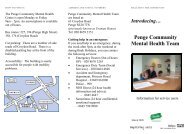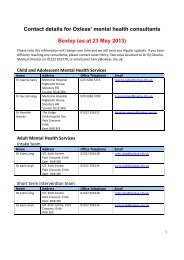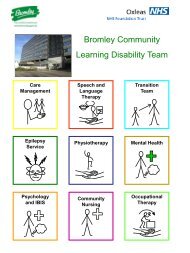Incident Management Policy and Procedure 652.0 KB - Oxleas NHS ...
Incident Management Policy and Procedure 652.0 KB - Oxleas NHS ...
Incident Management Policy and Procedure 652.0 KB - Oxleas NHS ...
Create successful ePaper yourself
Turn your PDF publications into a flip-book with our unique Google optimized e-Paper software.
One of the primary aims of the investigation team is to collect evidence. There is a vast array ofinformation <strong>and</strong> data surrounding any incident <strong>and</strong> this is particularly true for mental health incidents,which typically have relevant history that often spans years. The types of information required mayinclude the following, but this is not an exhaustive list:• healthcare records;• records of interviews with staff;• relevant results <strong>and</strong> diagnostic aids;• policies <strong>and</strong> protocols in protocols in operation at the time of the incident;• relevant integrated care pathways where available;• the initial incident report;• the list of key staff involved <strong>and</strong> written reports from staff.Interviews should be held to find out what happened <strong>and</strong> how <strong>and</strong> why it happened. The interviewprocess should be supportive <strong>and</strong> non-judgemental <strong>and</strong> be conducted in private. It is suggested thatthe cognitive interview approach is used for this purpose. Depending on where the incident took place,a site visit may help the team to establish whether the physical environment was a contributory factorin the incident. It can offer an insight into factors such as the line of sight between a member of staff<strong>and</strong> the service user affected by the incident or the positioning of equipment.Map eventsOnce the basic data about the incident have been collected, a facilitator will work with staff associatedwith the incident to piece together the chain of events. This can be a valuable forum for developingideas about how to adapt the system to prevent repeat incidents. Involving staff in this mappingexercise has been found to have a significant positive impact on the way a team works <strong>and</strong> engendersa sense of contributing to workable solutions. A tabular timeline or chronology is a useful way ofproviding this information as an appendix to the report.Identify problemsOnce information about the incident has been gathered, the problems in care <strong>and</strong> service deliveryshould be identified <strong>and</strong> prioritised. This enables analysis of aspects of the incident in an appropriateorder.Analyse informationThe problems in care <strong>and</strong> service delivery are then analysed to determine their underlying causes(contributory factors <strong>and</strong> root causes) <strong>and</strong> the lessons that can be learnt. The investigation teamshould consider the circumstances that individuals faced at the time <strong>and</strong> the evidence the team hadbefore it, <strong>and</strong> it should not be biased by either the outcome or hindsight.A number of tools are available <strong>and</strong> the following have been shown to work well across a number ofdifferent healthcare settings:• brainstorming;• change analysis;• nominal group techniques;• five whys techniques;• fishbone diagrams, based on the NPSA list of contributory factors:- patient factors;19

















